
Oleg Senchukov, Head of the Central ATM Security Center, and Nikolai Ivashov, Press Secretary of the Federal State Unitary Enterprise “State ATM Corporation”
The total area of responsibility of the Unified System is more than 26 million square meters. km In this area, 28 ATM ATM centres operate. One main centre and 7 zonal centres: Khabarovsk, Novosibirsk, Yekaterinburg, Samara, Rostov, Moscow and St. Petersburg. And these regional centres include 20 district centres, 12 of them with the right to plan, coordinate and issue permits for the use of airspace. At the same time, under the control of dispatchers, who directly control the air traffic, there are about 1,000 aircraft. The total length of routes for which air traffic control is carried out is over 800 thousand km.
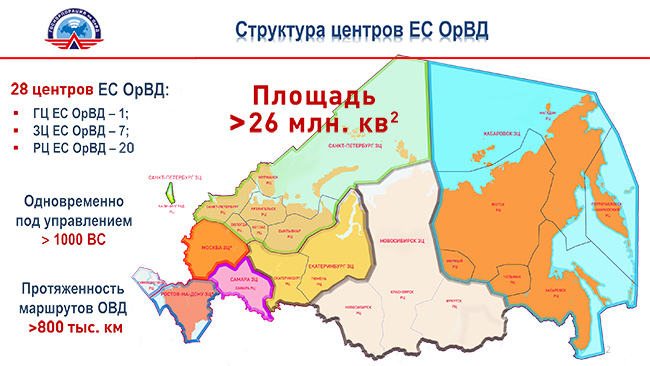
The area of responsibility zone zones are significantly different. If, for example, we compare the Samara and Khabarovsk zones, we see that there are 6 regional centres and 490 airfields in the Khabarovsk zone, and only one regional centre and 100 airfields in the Samara zone. The area of responsibility of the Khabarovsk zonal centre is 5-6 times larger than the Samara area of responsibility. In this case, the frequency of flights in Khabarovsk is not less. Through it pass flights from Alaska to Southeast Asia, and there the traffic density is decent. Indeed, in addition to managing flights over the territory of Russia, the ATM ATM has been delegated a part of the airspace over neutral waters. There are two oceanic centres, the Magadan and Murmansk centres. Air traffic control goes almost to the North Pole. There are international cross-polar routes.
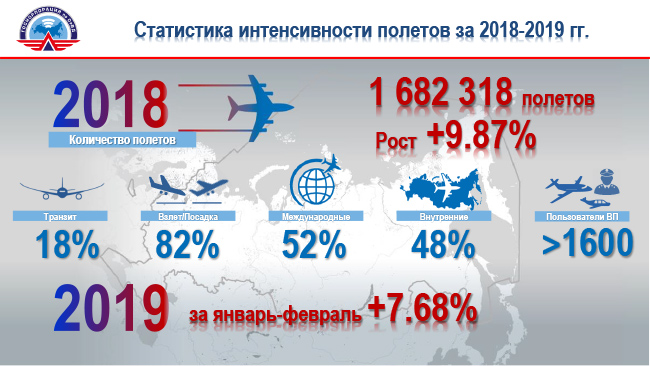
During 2018, 1 million 682 thousand flights were performed over the territory of Russia and the water area of our area of responsibility. 18% - flights that transit in the airspace of the Russian Federation. 82% of flights are vessels that take off and land on our territory. Of these, 52% are international, and 48% are domestic. Other users, including drones, launching balloons, blasting operations, including fireworks, and more, also use airspace. In 2018, more than 1600 applications were received from such users. The intensity of flights is growing every year by 7-10%. At the head of the organisational structure of the EU ATM is the Main Centre, below - integrated, zonal and regional centres. The zone centres, regional dispatch centres and aerodrome control centres are in the zone of responsibility of the regional and regional centres.
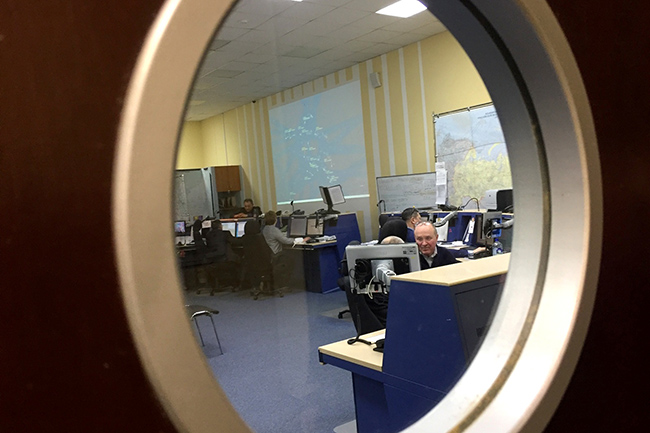
The main centre is a structural subdivision of the State Corporation for the organisation of air traffic and is located in the building of the General Directorate. The task of the EU Central ATM Centre is to ensure safe and economical use in the interests of citizens, the economy, the defence and security of the state, the airspace of the Russian Federation and beyond, where the responsibility for organising the movement is vested in the Russian Federation. The functions of the main centre include: Planning a TTI; Control over the flights of lettered aircraft; Air traffic flow management; Control over compliance with federal rules of the TTI, Coordination of emergency response activities, Registration of permits for international flights; Providing permits TTI. Directly air traffic control The main centre does not carry out. Here they are engaged in planning and issuing a permit for the use of airspace. This permission is the basis for direct control dispatchers to take over the aircraft for maintenance and give it their dispatch permits and instructions.
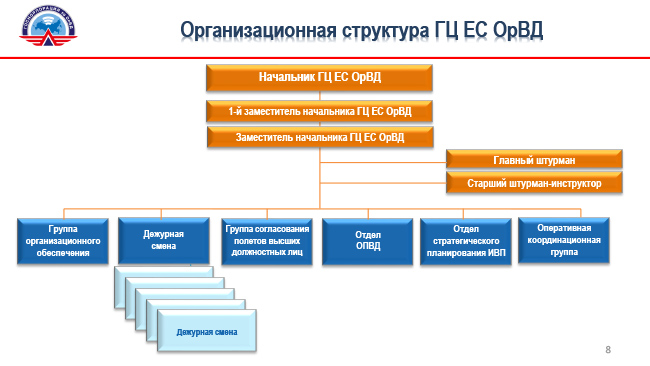
The staffing number of the Main Centre in January 2019 was 184 people. The main centre consists of several subdivisions: a shift on duty around the clock, with a staff of about 25 people; the senior officials flight coordination group (there are additional security measures when flying with heads of state, and this group is addressing these issues); air traffic flow planning; the strategic planning department and the operational-organisational group, where all information on deviations in the work of civil aviation flows, they also carry out round-the-clock watch.
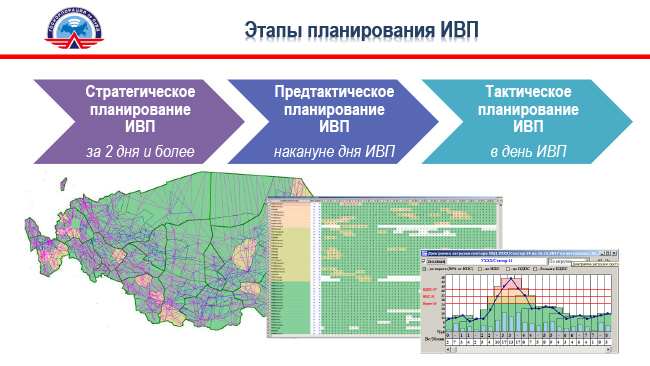
One of the main tasks of the Main Centre is to solve planning issues. There are several stages of flight planning: strategic planning is carried out for 2 or more days; pre-tactical planning - on the eve of the day of flight; tactical planning - carried out on the day of the flight. All airspace users apply for flight operations before commencing their activities. There are long-term flights that are scheduled, and there are applications that concern only one flight. The received application is analysed to determine whether there are any restrictions on this route, whether the declared aircraft has the right to perform the flight or not, whether it is registered or not. When conducting military exercises, restrictions are imposed on certain areas of the airspace where shooting, bombing and more are performed. Similarly, the application goes to the main centre and restrictions are imposed on this part of the airspace. At the same time, other airspace users are informed in order to ensure their safety.

For example, during the May 9 parade, the Main Centre is engaged in providing this event, imposing certain restrictions. Not all users are satisfied, but the Air Code of the Russian Federation contains the concept of state priorities, and, depending on what activity is carried out, one or another priority is used. Also, for the period of the Universiade in Krasnoyarsk, additional restrictions were introduced, and a special regime was introduced, which left a certain imprint on the work of the Unified system as a whole. There were restricted areas of flight operations in the Krasnoyarsk area, and restricted areas. Airspace users who had the need to fly in that zone had to perform an additional procedure, apply in advance and get permission. An interdepartmental headquarters was created, which considered these applications, and, if there were no problems in them, then permission was granted to carry out the flight.

The application (telegram) for the flight shows which flight, from where it flies, on which type of aircraft, describes its route, specifies alternate aerodromes and additional information if the airspace user considers it necessary. “Having received such an application, we bring it into our system, where the analysis is carried out: is there such a route or not, is there any height on this route that they want to use or not, are there restrictions on the route,” says the head of the central ATM network Oleg V. Senchukov. - And if everything suits us, we bring this information to the regional centres, to the airfields, and the dispatchers, having our permission, do not hesitate to take it in control. Most often, if there are no violations in the application, it is processed automatically, we turn to manual processing if something does not correspond. According to the regulations, from the moment of receipt of the application to the issuance of our opinion, permission or rejection - 20 minutes. This is the maximum even with manual processing. If the main centre dispatcher doesn’t even see it automatically, without any violations, it is processed instantly. The application must be submitted for international flights for 3 hours, for domestic flights - no later than 1 hour. ”

What is the point of organising flows. From the moment the engine starts at the airport of departure to the time of taxiing to the airport at the airport of arrival, the aircraft is transmitted from one dispatcher who manages in his sector to another, and so along the chain along the route. Each sector has a bandwidth requirement. Sometimes there are situations when at the same time in the same sector plan to get several aircraft. And this standard that exists may be exceeded. There is a special group that distributes these aircraft, i.e. they either adjust the time or assign a different route to reduce the peak load for the dispatcher.

All airspace of the Russian Federation is divided into 2 types. In one space, the permissive order is valid. Anything that rises into the air, or being on the ground, for example, blasting, plans to use the airspace, before starting its activities should receive permission to use it. The second type of airspace, where there is a notification procedure. That is, these are areas with low air traffic intensity. Here permission to use the airspace is not required, but the user is obliged to notify the Unified System that he will be there. And in the case of any emergency, emergency situations be sure that he will be given the necessary assistance. Also now by leaps and bounds we are developing flights of unmanned aerial vehicles. According to the current air legislation, in priority, they are significantly lower than flying helicopters and airplanes. Therefore, in accordance with the state priority, we choose who will fly and who will have to wait.
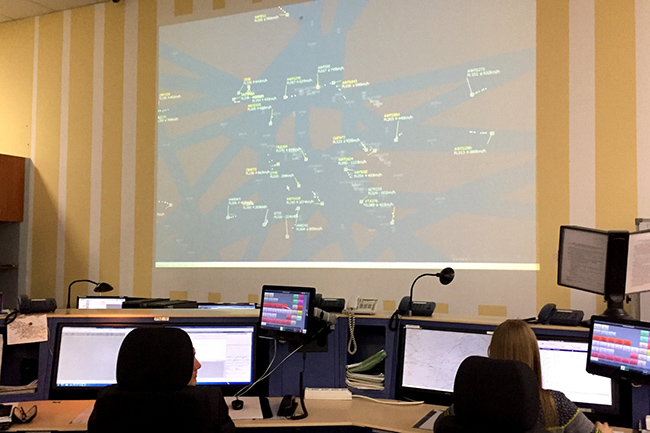
On the screen of the Operational Hall of the duty shift of the Main Centre, information from locators located in the Moscow Air Traffic Control Centre is displayed, and each mark is a mark from the aircraft that is currently in the air. The main centre is not directly involved in air traffic control, but radar information is needed in cases where there is an emergency on board, some kind of failure, it is allocated to observe where it is, in what condition, what height, what speed. Also, when performing lettered flights, when top officials of the states fly, they are taken under special control. It provides flights not only for civil aircraft, but also for military aircraft. 4 jobs - specialists who are engaged in military subjects, and 4 jobs - providing flights of civil aircraft.

There is a daily flight plan for civilian air forces, where all applications are submitted, both approved and unapproved. From the airport comes the information about the departure, about the landing. There are control points at which information about the passage comes in, all of which is reflected in this daily plan. If earlier in Soviet times the daily plan was a standard document that was on paper, it was approved, and it was impossible to add something to it. Now the daily plan is a conditional name. It covers the whole territory and is constantly changing. At present, there are 5871 applications in our daily plan, and this figure is increasing. Suppose the aircraft is flying from Southeast Asia, to fly for about 10 hours and it is already in our daily plan. And the board from Moscow, which today flies to the Eagle, will apply only 1 hour before departure. Then she will be added to the daily plan. On average, over 6000 applications are processed per day in winter. In the summer of about 7000 -7500 flights.
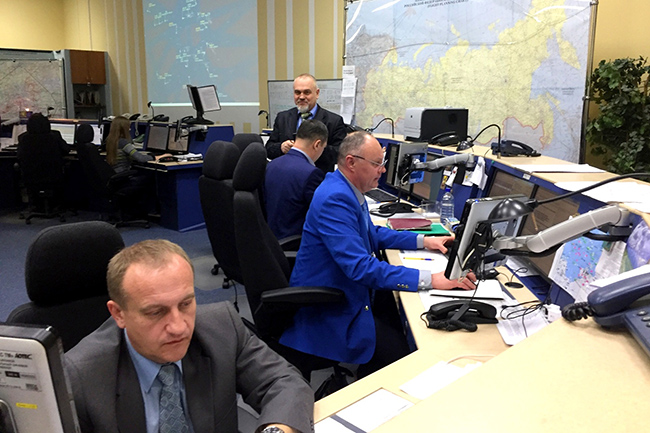
Here you can find all the information on the flight: what restrictions, mode of operation of aerodromes, alternate aerodromes, which routes are closed, whether heights are used correctly. Lots of information on this flight, which must be processed to give him permission. We can look at all the airways graphically. Especially when it comes to small private airplanes, helicopters that fly along routes, they very often turn to us, because it is impossible to see all this, you have to help them. And here comes information not only on flights that are monitored by the main centre - international flights and flights that are operated by more than two zone centres, information about traffic inside zone centres also arrives here. For example, the local line in the Khabarovsk zone, flew An-2, information about it is also located here.

At first glance it seems that there is so much air, where can any problems arise? But the flights are not just as desired, wherever I want to fly there. There are certain routes, certain points, and, when performing a flight, the aircraft crew must adhere to these lines / points that are mapped. If it becomes necessary to fly not along the airways, for example, a drone, a part of the airspace where there are no airways is reserved for it. Roughly speaking, the square is closed and everyone is informed that in this square, besides this drone, no one can fly. And he flies there. Or, let's say, launching of a space rocket, for example, from the Baikonur cosmodrome. And until the spacecraft reaches a certain height, the entire strip closes under the flight path for air traffic. And God forbid something happens to him and some aircraft will fall into this zone of falling debris. This is also the responsibility of the Main EU ATM Centre. Roscosmos sends the information, the specialists of the Main Centre calculate the strip of airspace that must be closed, and inform the airlines.











